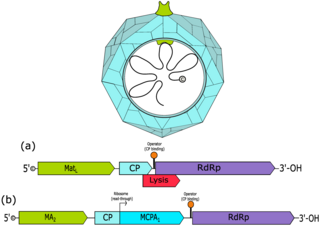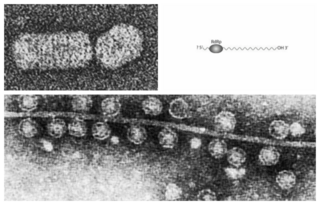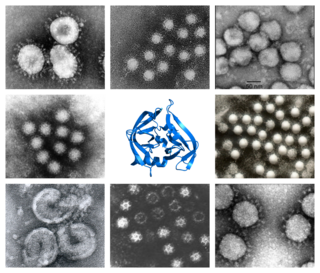| Tectiliviricetes | |
|---|---|
| Virus classification | |
| (unranked): | Virus |
| Realm: | Varidnaviria |
| Kingdom: | Bamfordvirae |
| Phylum: | Preplasmiviricota |
| Class: | Tectiliviricetes |
| Orders | |
Tectiliviricetes (from tectivirid-like) is a class of viruses. [1]
| Tectiliviricetes | |
|---|---|
| Virus classification | |
| (unranked): | Virus |
| Realm: | Varidnaviria |
| Kingdom: | Bamfordvirae |
| Phylum: | Preplasmiviricota |
| Class: | Tectiliviricetes |
| Orders | |
Tectiliviricetes (from tectivirid-like) is a class of viruses. [1]
The class contains the following orders: [1]
Additionally, one family is unassigned to an order: Autolykiviridae . [1]
Virus classification is the process of naming viruses and placing them into a taxonomic system similar to the classification systems used for cellular organisms.

Fiersviridae is a family of positive-strand RNA viruses which infect prokaryotes. Bacteria serve as the natural host. They are small viruses with linear, positive-sense, single-stranded RNA genomes that encode four proteins. All phages of this family require bacterial pili to attach to and infect cells. The family has 185 genera, most discovered by metagenomics. In 2020, the family was renamed from Leviviridae to its current name.

Plasmaviridae is a family of bacteria-infecting viruses. Acholeplasma species serve as natural hosts. There is one genus in the family, Plasmavirus, which contains one species: Acholeplasma virus L2. All viruses known in this family have been isolated from species in the class Mollicutes.
Papovaviricetes is a class of viruses. The class shares the name of an abolished family, Papovaviridae, which was split in 1999 into the two families Papillomaviridae and Polyomaviridae. The class was established in 2019 and takes its name from the former family.
Arfiviricetes is a class of viruses.
Preplasmiviricota is a phylum of viruses.
Revtraviricetes is a class of viruses that contains all viruses that encode a reverse transcriptase. The group includes all ssRNA-RT viruses and dsDNA-RT viruses. It is the sole class in the phylum Artverviricota, which is the sole phylum in the kingdom Pararnavirae. The name of the group is a portmanteau of "reverse transcriptase" and -viricetes which is the suffix for a virus class.

Ghabrivirales is an order of double-stranded RNA viruses. It is the only order in the class Chrysmotiviricetes. The name of the class is a portmanteau of member families: chrysoviridae, megabirnaviridae, and totiviridae; and -viricetes which is the suffix for a virus class. The name of the order derives from Said Ghabrial, a pioneering researcher who studied viruses in this order, and -virales which is the suffix for a virus order.

Lenarviricota is a phylum of RNA viruses that includes all positive-strand RNA viruses that infect prokaryotes. Some members also infect eukaryotes. Most of these viruses do not have capsids, except for the genus Ourmiavirus. The name of the group is a syllabic abbreviation of the names of founding member families "Leviviridae and Narnaviridae" with the suffix -viricota, denoting a virus phylum.

Pisoniviricetes is a class of positive-strand RNA viruses which infect eukaryotes. A characteristic of the group is a conserved 3C-like protease from the PA clan of proteases for processing the translated polyprotein. The name of the group is a portmanteau of member orders "picornavirales, sobelivirales, nidovirales" and -viricetes which is the suffix for a virus class.

Adnaviria is a realm of viruses that includes archaeal viruses that have a filamentous virion and a linear, double-stranded DNA genome. The genome exists in A-form (A-DNA) and encodes a dimeric major capsid protein (MCP) that contains the SIRV2 fold, a type of alpha-helix bundle containing four helices. The virion consists of the genome encased in capsid proteins to form a helical nucleoprotein complex. For some viruses, this helix is surrounded by a lipid membrane called an envelope. Some contain an additional protein layer between the nucleoprotein helix and the envelope. Complete virions are long and thin and may be flexible or a stiff like a rod.
Naldaviricetes is a class of viruses, which infect arthropods. Members of Naldaviricetes are characterized by large enveloped rod-shaped virions, circular double-stranded DNA genomes, and replication in the nucleus of the host cell. All of them share a set of unique genes not found in other viruses, which include the presence of multiple interspersed direct repeats, various subunits of DNA polymerase and RNA polymerase, four late expression factor genes, and infectivity factor genes suggesting a common host entry mechanism.
Lefavirales is an order of viruses of the class Naldaviricetes. Viruses of this order have Hexapoda and Crustacea as their hosts, including Adoxophyes and Carcinus
Leviviricetes is a class of viruses, which infect prokaryotes. Most of these bacteriophages were discovered by metagenomics.
Norzivirales is an order of viruses, which infect prokaryotes. Most of these bacteriophages were discovered by metagenomics.
Atkinsviridae is a family of RNA viruses, which infect prokaryotes.
Solspiviridae is a family of RNA viruses, which infect prokaryotes.
Blumeviridae is a family of RNA viruses, which infect prokaryotes.
Duinviridae is a family of RNA viruses, which infect prokaryotes.
Timlovirales is an order of viruses, which infect prokaryotes. Most of these bacteriophages were discovered by metagenomics.